|
[
HOME
]
|
|
Model Information
|
|
|
|
VW Service
|
|
|
|
Winnebago Service
|
|
|
|
Tours & Pictures
|
|
|
|
►
Related
Links
|
| |
The propane leak detector is hard wired to the coach battery system. It draws
a significant amount of power and that's the main reason why there is no internal
dry-cell battery otherwise you'd be changing it every week. I also suspect that
there are some Federal laws, DOT rules, or perhaps just the RV Manufacturer's Association
guidelines that require all LPG detectors to be hard wired to the vehicle's wet
battery system. Even adding these on-off switches may be a violation of law but
let's not tell anybody just yet.
The main reason for wanting such an on-off switch is to avoid running down the
batteries when the vehicle is stored for a long period of time, such as through the
winter months in the northerly states. When the batteries are run down, they are
more susceptible to freezing from the cold temperatures. When the vehicle is stored,
either the batteries must be disconnected or the LPG detector turned off.
The actual location of the LPG detector varies by model, but shown here are two
different versions of adding such a switch. There is nothing magical about the wiring
for such a switch; all the switch does is interrupt one of the power wires leading
to the detector. I'd like to see somebody come up with a modification of adding
the switch but locating it right in the LPG tank compartment which is where it probably
belongs. Besides not messing up the original interior, putting the switch in the
tank compartment would make sense because when you turn on or off the propane, you'd
be able to turn on or off the detector all at the same time and in the same location.
|
Like most of us we rarely have occasion to use our propane
systems (cook top, refrigerator, space heater) consequently the shutoff valve
at the propane tank remains closed most of the time. Yet the propane “leak
detector” remains on all the time and, unlike the smoke detector, it draws
a significant amount of power, between 0.05 and 0.10 amps. If it were powered
by an internal battery, similar to a smoke detector, you would have to put
a new battery in it a couple of times a week, that’s why it’s hard wired to
the coach battery.
During regular use of the vehicle that is not a problem,
but in storage or periods of infrequent use, it can add up to dead (or if
you live up north frozen) coach batteries. And even though the coach batteries
are referred to as deep cycle batteries, they really don’t like to be discharged
much below 50%, it significantly shortens their lives.
So, what’s the answer? Our answer to this situation was
quite simple, just install an on-off toggle switch in the power feed to the
detector. Then when you turn on the propane valve, turn on the detector and
vice versa.
|
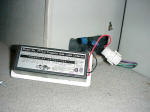
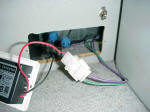
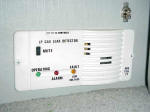
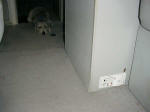 |
| In our Model 2000HD the detector
is mounted just to the left of the coach door in the refrigerator housing
wall. It’s flush mounted, held in with two screws and easy to remove to
access the power wires. I mounted and wired the toggle switch just above
the detector so that by looking at the detector and observing the pilot
light I know its status. Having that propane detector in operating condition
when dry camped is very important as that is the time when a life threatening
situation could develop. Anyway, it’s no big thing,
just another little refinement that makes the “Little Darling” that much
sweeter!!
|
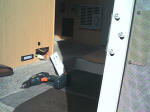
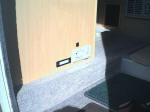 |
| 2Installed an ON/OFF switch on the LP Gas
Detector. I tuck the switch on the inner side of the detector to prevent
accidental tripping of the switch. |
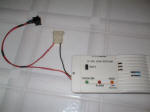
 |
Additional Modifications:
|
